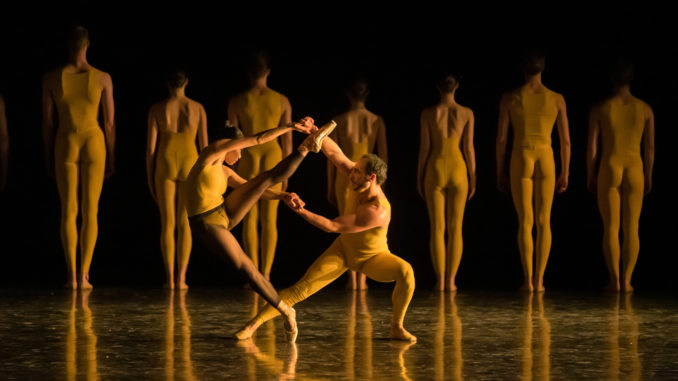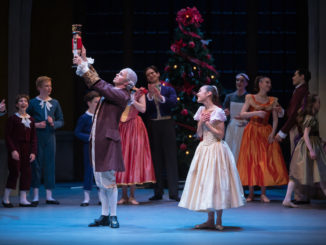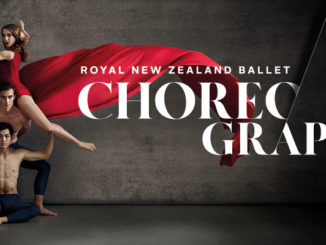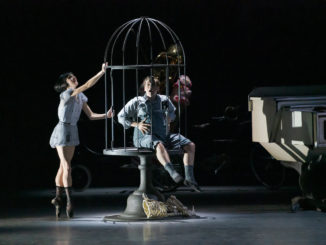
[Decade Defining]
Bold Moves presents a mixed bill of contrasting dance works, each definitive for its decade, each contributing to the living vocabulary of ballet in the modern era. The Royal New Zealand Ballet website promotes the show as a triple bill of ensemble works featuring George Balanchine’s Serenade, Andrea Schermoly’s Stand to Reason, and William Forsythe’s Artifact II. At some point a fourth work has been added, the Flames of Paris pas de deux, an extract of the Vasily Vainonen ballet of the same name.
Serenade is the first ballet Balanchine created in the USA, appearing as a student work in 1934 for the School of American Ballet. Serenade has been reworked several times, and consists of four movements: Sonatina, Waltz, Russian Dance and Elegy. It is 40 years since the Royal New Zealand Ballet first staged Serenade, a work that is considered by many to be a milestone in the history of dance. Costumed in pale blue against a blue background, it is a moonlit work of grace, length, line and symmetry. Guest Principal Simone Messmer and Principal Allister Madin are perfectly cast, embodying the choreography with grace and mastery. There are plenty of strong performances from the large ensemble of dancers, including (but not limited to) Katherine Skelton, Katherine Minor, Leonora Voightlander, Kirby Selchow and Madeleine Graham all of whom are especially vibrant and polished. Balanchine is consistently rich and entertaining ballet, and while there is always plenty to look at, the work’s mood and tone allow the audience to relax and enjoy themselves, allowing their thoughts to unfold free of any pressure to search for subtext. Serenade will be at its best in Auckland on the Aotea Centre stage, allowing the company more space and the audience the depth and perspective to fully appreciate the kaleidoscopic ensemble of dancers onstage.
Flames of Paris, a Soviet-era ballet produced to celebrate revolutionary ideals and connect classical ballet to the proletariat and events of the day, was first staged in the 1930s and reconstructed in 2008 for the Bolshoi Ballet. Although the full-length ballet is based on the events of the French Revolution, the Flames of Paris pas de deux is a joyous, effervescent piece of choreography, celebrating the virtuosity of its dancers within the established format of partnering and solos. Principal Maya Tanigaito and company Artist Laurynas Véjalis realise Vasily Vainonen’s choreography with confidence and charisma. Véjalis sustains detailed and impressive elevation, despite at times having to work against the rake of the Opera House stage, and Tanigaito switches on her star quality – quick, effortless and warm. Always remarkable is Tanigaito’s plumb line; she is so perfectly centered that she manages the most demanding fouettés and pirouettes whilst barely spotting at all. Flames of Paris feels pleasing yet lightweight, and although it’s very well executed it doesn’t seem to sit naturally with the other ensemble works in Bold Moves.
Stand to Reason by Andrea Schermoly was commissioned for the 2018 Wellington-only season Strength & Grace, featuring four new ballets by women choreographers in recognition of the 125th anniversary of women’s suffrage in New Zealand. The work deserves this restaging, and to be seen by audiences throughout the country. Schermoly approached the provocation of the Strength & Grace season academically, and the result is a work of sensitivity, depth, and intelligence. The Women’s Christian Temperance Union distributed a pamphlet describing ten clear reasons why women should vote, and it is this heartfelt, logical writing that underpins Stand to Reason. Schermoly’s comments about womens’ experiences of having to explain and re-explain (our reasons, our value, our worth, our experiences, the challenges to our authority and equality) resonate with many audience members. In this way, the work is simultaneously historically accurate and poignantly current. Set to a mixed score, including to sound of the ten reasons being typewritten as they are projected, Stand to Reason finishes with Beethoven’s Moonlight Sonata, an instantly recognisable piece of music that could easily overshadow a lesser choreography. Schermoly’s rich, unexpected, rhythmic movement vocabulary is expressive without becoming laboured, graceful yet perfectly awkward. Madeleine Graham is detailed, superbly grounded, wonderfully connected. Kirby Selchow, as in the premiere of this work, is sublime. Her power, clarity, articulation, isolation and artistry are second to none. Here is a dancer thoroughly deserving of promotion to Soloist, and I am surprised that she is not there already, given the range and weight of the roles she has danced in recent seasons. I do notice the absence of Abigail Boyle and Maya Tanigaito in Stand to Reason, for the sophistication of expression these more experienced women bring to a work of this depth.
Bold Moves finishes with Artifact II, the second act of the full-length Artifact which was choreographed in 1984 by William Forsythe during his first year as the Artistic Director of Frankfurt Ballett. The work employs a range of theatrical devices, including a curtain repeatedly thumping down mid-choreography, each time lifting to reveal a repositioned ensemble like an enforced and extended blink. The stage is bare; legs flown out to reveal most of the backstage area. Forsythe’s cohesive design includes light, costume, movement and sound synergised into one complete art experience; Artifact II is a great example of this, encouraging the audience to experience rather than observe – a subtle yet deliberate difference. The large ensemble are engaged for musical staging rather than intensive dancing, creating shifting peripheries and interplay with the lights in a regimented, quirky fashion. Firmly juxtaposed to the ensemble are double pas de deux partners Mayu Tanigaito with Massimo Margaria, and Nadia Yonowsky with Paul Mathews. Forsythe’s choreographic skill is exemplified with this inventive and bold movement, which showcases all four dancers’ talents beautifully. Kirby Selchow is the elusive woman in grey, a visual point of contrast from the expansive fluidity of the pas de deux dancers. Artifact II loses some context when it is presented without the other three acts of the full length ballet, particularly in terms of thematic clues offered by voice and costuming, and it would be ideal for New Zealand audiences to see complete international works too.
Bold Moves is a strong, successful season and presents the Royal New Zealand Ballet as a well-rehearsed and versatile company of dancers.
Bold Moves plays Wellington’s Opera House until 18 August. It then tours to Auckland, Palmerston North, Christchurch, Dunedin, and Napier.
Choreography: George Balanchine, Andrea Schermoly, Vasily Vainonen, William Forsythe
Music: Pytor Ilyich Tchaikovsky, Boris Assafieff, Johann Paul von Westhoff, Ludwig van Beethoven, Marin Marias, Johann Sebastian Bach
Costume Design: Barbara Karinska, Patricia Barker, Donna Jefferis and Esther Lofley, William Forsythe
Projection Design: Will Funk
Lighting Design/Realisation: Nigel Percy, Andrew Lees




Leave a Reply